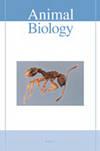Weapon shape variation of male morphotypes in two freshwater prawn species genus Macrobrachium (Decapoda: Palaemonidae)
IF 0.9
4区 生物学
Q2 ZOOLOGY
引用次数: 2
Abstract
Many animal groups can develop weapons that originate from specialized modifications in different body regions. Decapods are a classic example of organisms that develop these weapons. In this group, we can find specific appendages modified to claws that are used during agonistic conflicts, as is the case between dominant and submissive male morphotypes in freshwater prawns. Our study aimed to analyze the shape, size, and morphological integration of claw components (propodus and dactyl) in male morphotypes of two freshwater prawn congeners (Macrobrachium amazonicum and M. brasiliense). Claws of the prawns were photographed and marked with landmarks and semilandmarks for the acquisition of shape variables. The shape of the propodus and dactyl was statistically different between almost all morphotypes of the two species. The size of structures differed statistically between all morphotypes. The claws of almost all morphotypes showed a high degree of morphological integration; however, statistical differences were observed only between the morphotypes of M. brasiliense. The variation in the shape and degree of morphological integration of the claws between the morphotypes of M. amazonicum was less evident when compared to the morphotypes of M. brasiliense, which may be related to distinct patterns in the development of chelipeds of each species, that is, homochely and heterochely, respectively. Thus, the exaggerated development of a cheliped (heterochely) can cause greater variation in the shape of this structure, also influencing the degree of morphological integration between its components, as evidenced in this study.大臂虾属两种淡水对虾雄性形态的武器形态变异(十足目:对虾科)
许多动物群体可以开发出源自不同身体区域的专门改造的武器。十足类是开发这些武器的生物的典型例子。在这一组中,我们可以发现在痛苦冲突中使用的特定附肢,比如淡水对虾中显性和顺从的雄性形态类型。我们的研究旨在分析两种淡水对虾同源物(亚马逊沼虾和巴西对虾)雄性形态类型中爪成分(蜂胶和dactyl)的形状、大小和形态整合。对对虾的爪子进行拍照,并用地标和半圆标记来获取形状变量。在这两个物种的几乎所有形态类型中,蜂胶和dactyl的形状在统计上都有所不同。结构的大小在所有形态类型之间存在统计学差异。几乎所有形态类型的爪都表现出高度的形态整合;然而,仅在巴西分枝杆菌的形态类型之间观察到统计学差异。与巴西M.brasiliense的形态类型相比,亚马逊M.amazonicum形态类型之间爪子的形状和形态整合程度的变化不太明显,这可能与每个物种螯足发育的不同模式有关,即分别为同螯和异螯。因此,螯合物(杂环)的过度发育会导致该结构的形状发生更大的变化,也会影响其成分之间的形态整合程度,正如本研究所证明的那样。
本文章由计算机程序翻译,如有差异,请以英文原文为准。
求助全文
约1分钟内获得全文
求助全文
来源期刊

Animal Biology
生物-动物学
CiteScore
2.10
自引率
0.00%
发文量
34
审稿时长
3 months
期刊介绍:
Animal Biology publishes high quality papers and focuses on integration of the various disciplines within the broad field of zoology. These disciplines include behaviour, developmental biology, ecology, endocrinology, evolutionary biology, genomics, morphology, neurobiology, physiology, systematics and theoretical biology. Purely descriptive papers will not be considered for publication.
Animal Biology is the official journal of the Royal Dutch Zoological Society since its foundation in 1872. The journal was initially called Archives Néerlandaises de Zoologie, which was changed in 1952 to Netherlands Journal of Zoology, the current name was established in 2003.
 求助内容:
求助内容: 应助结果提醒方式:
应助结果提醒方式:


